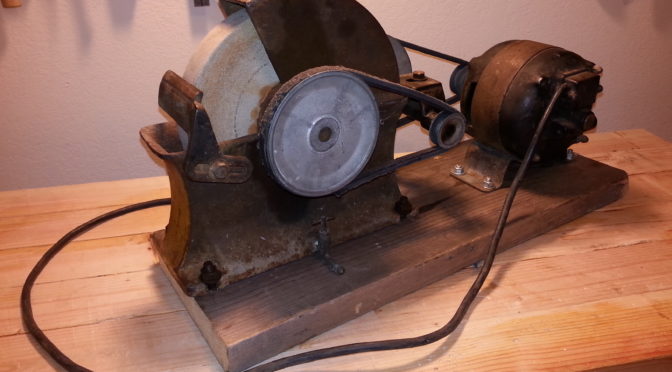Today was a great day. I got up early to head out to the Saratoga Fire Station to take my Amateure radio Extra class exam. I am happy to report that I can now use the temporary callsign KK6GXG/AE, for those not in Ham radio, that means I passed. Needless to say I was stoked to reach this, the highest level of amateure radio licence. Lots of plans are piling up for radio projects on my desk/bench so there will be reports on those to come, this post however, is not about radio.
 After the test the wife and I went to the De Anza College Flea Market. I found something I have been looking for for a long time, a sharpening stone (wet stone) grinding wheel. What I had been looking for was a manual, or hand-crank type that can be easily adapted to a foot-treadle or bow-spring drive. The one that I found was attached to a motor via a reduction pulley-and-belt system, though in honesty I didn’t realize how low the reduction was at first.
After the test the wife and I went to the De Anza College Flea Market. I found something I have been looking for for a long time, a sharpening stone (wet stone) grinding wheel. What I had been looking for was a manual, or hand-crank type that can be easily adapted to a foot-treadle or bow-spring drive. The one that I found was attached to a motor via a reduction pulley-and-belt system, though in honesty I didn’t realize how low the reduction was at first.
My initial reaction was to remove the motor and adapt the wet-grinder to a manual power source right off the bat. After looking up the patent info on the motor and seeing what it was originally intended for a story began to emerge on the origins of this particular assemblage.
The board everything is mounted on does not appear to be that old. The dimensions are modern, making the mounting 2 x 12, at oldest, from the 60s. The mounting hardware is a mix of 50s and contemporary. The casting and markings of the wet-grinder suggest that it was cast in the 1920s to 1930s. The patent date of the motor is from 1926. This particular 1/4 HP motor was designed for washing machines of the 20s and 30s. A newer motor was produced after the war and the model and frame numbers on the data plate suggest that this motor was produced in the 30s.
 The story I have come up with is that these parts were cobbled together in their current configuration some time the 70s from parts and used regularly for a significant time as such and eventually shelved in a shed where they had been sitting for at least a decade.
The story I have come up with is that these parts were cobbled together in their current configuration some time the 70s from parts and used regularly for a significant time as such and eventually shelved in a shed where they had been sitting for at least a decade.
I ended up doing a mechanical teardown tonight. I was planning on getting started with the electrical teardown and testing tomorrow. For the most part this was an inspection teardown. I didn’t do any “repair” although I did fill the water reservoir with a rust remover to begin prepping it, and to see if it still holds fluid. I didn’t detect any leaks and we will see if it develops any overnight.
 The plan is to deal with the mechanical and electrical as completely separate restorations. The mechanical is the primary because I can still set it up as a manual wet-grinder and begin using it.
The plan is to deal with the mechanical and electrical as completely separate restorations. The mechanical is the primary because I can still set it up as a manual wet-grinder and begin using it.
I have a number of sharpening projects that need to get done soon and this would be a big help in speeding things up. Once rust is abated I think a couple of coats of iron oxide primer followed up with a couple of coats of oil-based paint should provide a sufficient level of protection.
Once the mechanicals are all taken care of I will spend some time on the electrical motor. At this time I have no information on the motor other than what’s on the data plate.
 So why the title “Acceptable Tech Level”? one of the reasons I wanted a manual grinder was to further the off-grid hand tool goals I have been trying to work with. With this particular configuration I can easily swing it over to manual and with the motor most likely being from the 20s-30s it falls into my era of interest in aircraft and is also from around the same time as several of my inherited and acquired hand tools meaning it fits right in with many of my vintage tools. The important part is that it CAN be used with manual power.
So why the title “Acceptable Tech Level”? one of the reasons I wanted a manual grinder was to further the off-grid hand tool goals I have been trying to work with. With this particular configuration I can easily swing it over to manual and with the motor most likely being from the 20s-30s it falls into my era of interest in aircraft and is also from around the same time as several of my inherited and acquired hand tools meaning it fits right in with many of my vintage tools. The important part is that it CAN be used with manual power.
Until next time…
☮ ♥ ✈ & 73,
~FlyBoyJon / KK6GXG

